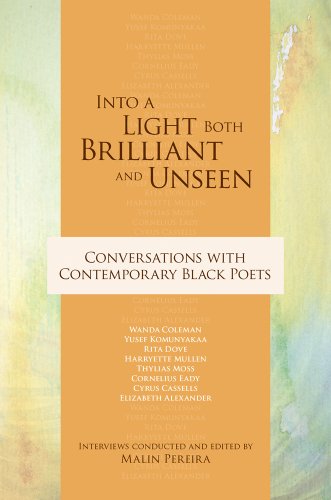‘Into A Light Both Brilliant And Unseen’

By E. Ethelbert Miller
Today there are major developments taking place in the field of African American poetry. Unfortunately there has been a tendency to simply produce and promote and not take time to make serious “probes” into what is going on. Several years ago, while teaching at George Mason University, I directed my students to critically examine the work of African American poets associated with the Dark Room Collective, Cave Canem and the Callaloo publication.
I also continued my own reading and note-taking and reached the conclusion that there are about 35 African American poets (currently living) who will probably play a key role in the advancement of African American literature as well as culture in the 21st century. At any given time in a historical period there are a few writers who emerge because of literary politics, and to some extent talent. Which brings me to the important book, “Into A Light Both Brilliant And Unseen,” edited by Malin Pereira, a professor and chair of the Department of English at the University of North Carolina. Here are conversations, and not simply interviews with eight African American poets. Some took place by email, which should be noted. An email response by a writer can often give that individual an opportunity to “craft” responses as well as undertake the task of reinventing oneself. Personal hyperbole might be a good term for this.
Of the eight poets, included in this book, (Wanda Coleman, Yusef Komunyakaa, Rita Dove, Harryette Mullen, Thylias Moss, Cornelius Eady, Cyrus Cassells, Elizabeth Alexander) I know seven of them. I’ve read their work and the various interviews journalists and scholars have conducted with them. I’ve also corresponded with a few of the poets in Pereira’s book on a regular basis. I say this because I found her book filled with wonderful new stuff. It was as if these poets were all in the middle of running for public office and Fox News suddenly ran a newsbreak.
Who knew how Wanda Coleman felt about Yusef Komunyakaa, or how Cornelius Eady felt about owning property?
But we also know that Malin Pereira is white and her own opinions and thoughts soon dominate this collection of conversations. Pereira wants to look at black poets after the Black Arts Movement (BAM). Her focus is on the work of writers who started publishing books in the 1980s and 1990s. Pereira defines BAM as taking place between 1964-1975. She unfortunately only defines BAM as being a movement concerned with blackness. So many of her questions to the “Talented 8” bait them into making statements that are both “mystical” and post-racial. None of the writers are asked any political questions that might have illustrated what happened to African American literature after 1975. The failure of Pereira to ask her poets anything dealing with revolution or Islam creates a generation of bubble poets. The idea of revolution and the presence of Islam within BAM was as important as the concept of blackness. If one simply follows the career of June Jordan after 1975, one will find this progressive black woman poet being influenced by events taking place in Nicaragua South Africa, as well as Bosnia. I know many of us like to talk about being the children of Whitman, but can’t we remember June Jordan as a Great Aunt?
Malin Pereira seems to be constantly amazed that many of the poets in her book are not more widely known. But what is her map of the known world? During 1975- 1980, many black poets were being published in such magazines as Hoo-Doo, Obsidian and Callaloo. I recall having an argument with Ahmos Zu-Bolton about placing one of Yusef Komunyakaa’s poem on the cover of an issue of Hoo-Doo. Ahmos is one of those “lost” writers that scholars like Pereira will probably overlook, even though he was the publisher of Harryette Mullen’s first chapbook.
Overall, I like what Malin Pereira has done. She has black poets talking about craft, poetry and their lives. However, she needs to understand the tradition and genius that comes before the “Talented 8.” If she is amazed that someone like Cyrus Cassells speaks several languages, that’s wonderful, but so did Langston Hughes.
Pereira has given us a book that pulls us into a light both brilliant and unseen. Hopefully, other future scholars will open their eyes and be given back their sight.
INTO A LIGHT BOTH BRILLIANT AND UNSEEN Edited by Malin Pereira, 260 pages, University of Georgia Press.
E. Ethelbert Miller, is the editor of Poet Lore, the oldest poetry magazine published in the US.
